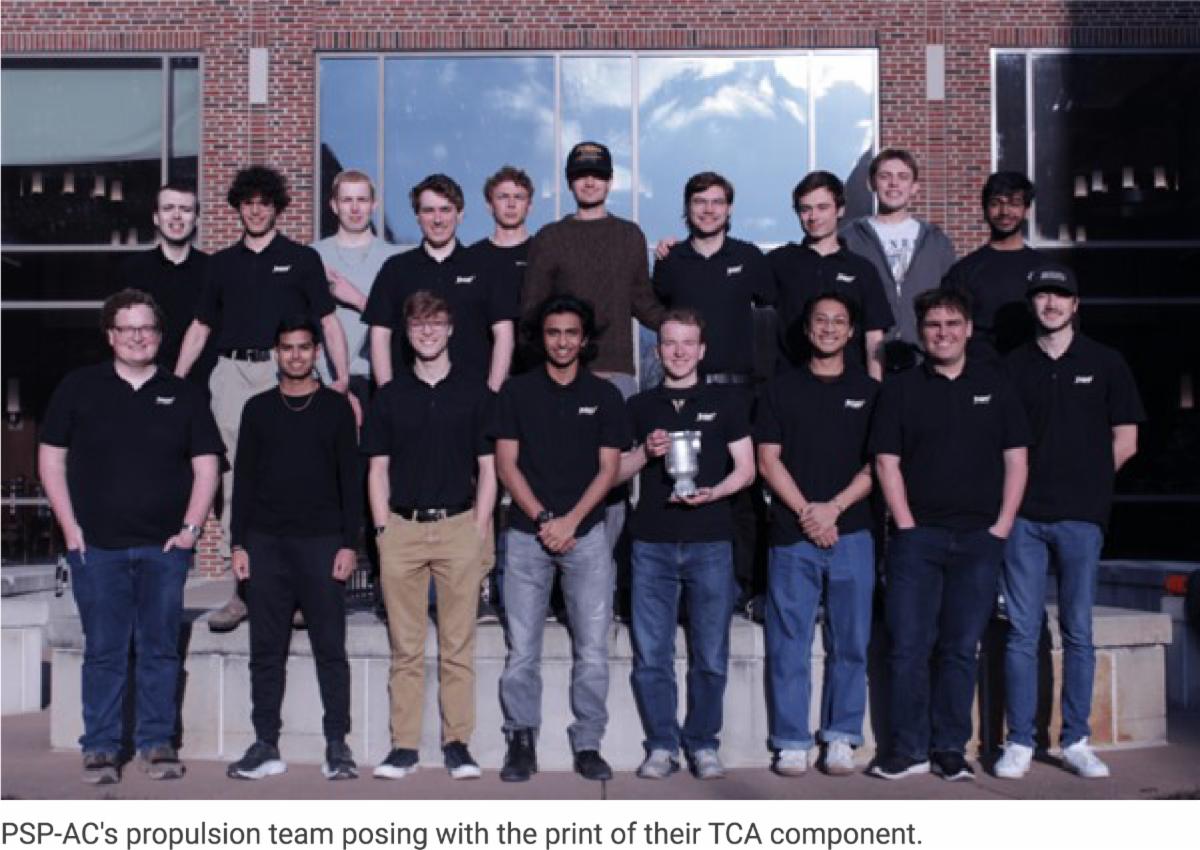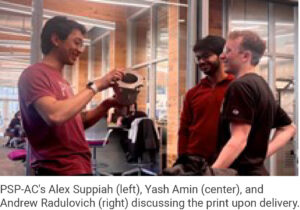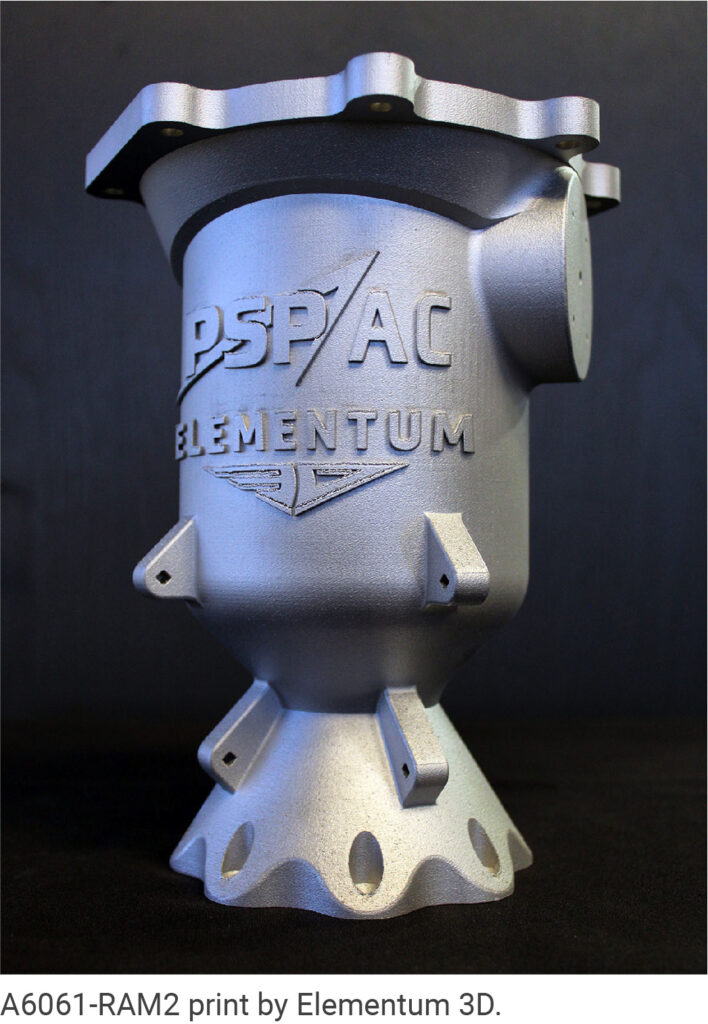Self-landing rockets essentially changed the space sector, transforming it from a niche research segment to fully fledged industry. To continue driving the technology forward, new generations of engineers are expanding the technology’s possibilities. This includes the Purdue Space Program-Active Controls (PSP-AC) at Purdue University, who are leveraging novel materials combined with additive manufacturing to advance vertical take-off and vertical-landing.
Made up of 50 undergraduate students, the PSP-AC team were aiming to meet and surpass the Collegiate Propulsive Lander Challenge benchmarks by developing self-landing rocket technology. To do so, the group is developing a TADPOLE, a propulsion system for a bipropellant hopper vehicle. TADPOLE’s design requirements included long burn times, a regenerative cooling circuit, and thrust vector control. In turn, the team crafted a thrust chamber assembly (TCA) that only 3D printing could produce.

Aluminum is often chosen for rocket TCAs due to its excellent thermal conductivity, lightweight, and favorable strength-to-weight ratio. However, it is only more recently that the material has become more widely used in AM due to how this high thermal conductivity, as well as reflectivity, impacts the laser powder bed fusion (LPBF) process. One of the key ingredients to improving aluminum’s printability is slowing the rate of printing, which decreases overall productivity and, in turn, machine amortization.
Among those advancing the state of the art in metal materials for AM is Elementum 3D, whose A6061-RAM2 aluminum alloy addresses these printability issues. According to the firm, this material allows for a real part deposition rate approximately 50% higher than the commonly used AlSi10Mg when printed on an EOS M290 system, which translates to more economical production. Additionally, because the powder results in a surface finish that smoother than the alternative, it offers better heat transfer and thermal and mechanical properties.
 Because A6061-RAM2 exhibited the necessary yielding characteristics for the TADPOLE, which operates at a chamber pressure of 250 psi and deliver a thrust of 550 lbf, it was picked for the project. The enhanced durability of the TCA allowed the team to conduct a more extensive series of tests, which translated over to improving their experience in propulsion system design and experimentation.
Because A6061-RAM2 exhibited the necessary yielding characteristics for the TADPOLE, which operates at a chamber pressure of 250 psi and deliver a thrust of 550 lbf, it was picked for the project. The enhanced durability of the TCA allowed the team to conduct a more extensive series of tests, which translated over to improving their experience in propulsion system design and experimentation.
“We are honored to offer our team’s AM knowledge, expertise, and technology to inspire all the students involved in the Purdue Space Program to push the limits of conventional thinking and print the first ever A6061-RAM2 thrust chamber assembly,” said Dr. Jacob Nuechterlein, Elementum 3D’s Founder and President.
By partnering with Elementum, the college team was afforded the additional educational experience of industrial collaboration. Specifically, Elementum’s engineering experts assisted in the group’s design strategies for efficient powder removal from the printed parts, which was found to be more straightforward than cleaning out conventional GR-COP alloys.

The students also gained access to comprehensive data on the material properties of the alloy, a level of detail that had been challenging to obtain from other suppliers. This influx of detailed information provided them with the insights needed to accurately simulate the Thrust Chamber Assembly’s behavior and performance, laying the groundwork for validating their designs against the experimental results from engine tests.
“The whole process is a great engineering challenge and learning experience that was made possible by Elementum 3D’s support. PSP-AC will use these simulations and experimental results to design their next engine,” said Andrew Radulovich, PSP-AC chief engineer.
Naturally, the experience will influence the Purdue students as they move onto their professional careers, a benefit that can’t be understated for Elementum 3D. As we’ve seen with other student space groups, these college endeavors can lead to world-changing projects. This was the case for Relativity Space, whose co-founder, Jordan Noone, started out running University of Southern California’s Rocket Propulsion Lab. Just as Noone went onto help develop the world’s largest metal 3D printer, the Purdue team will certainly be moving onto even bigger and brighter things. And, when they do, they’ll be taking Elementum’s powder expertise with them.
Subscribe to Our Email Newsletter
Stay up-to-date on all the latest news from the 3D printing industry and receive information and offers from third party vendors.
You May Also Like
3D Printing Webinar and Event Roundup: April 21, 2024
It’s another busy week of webinars and events, starting with Hannover Messe in Germany and continuing with Metalcasting Congress, Chinaplas, TechBlick’s Innovation Festival, and more. Stratasys continues its advanced training...
3D Printing Webinar and Event Roundup: April 14, 2024
We’re starting off the week’s 3D printing webinars and events at ASTM AMCOE’s 11th Snapshot Workshop and MACH Exhibition. Stratasys continues its advanced training courses, SME is holding a virtual...
Polly the Duck to Receive 3D Printed Bill Prosthetic
In Williamson County, Texas, a story of resilience, innovation, and cross-community effort is unfolding, illustrating the bond between humans and wildlife. All Things Wild, a wildlife rehabilitation center, has been...
3D Printing News Briefs, April 3, 2024: Kickstarter FDM 3D Printer, Artificial Eyes, & More
In 3D Printing News Briefs today, we’re talking about an FDM 3D printer on Kickstarter, advancements in artificial eye creation, and 3D printed solenoids for electromagnets. Then we’ll move on...
































